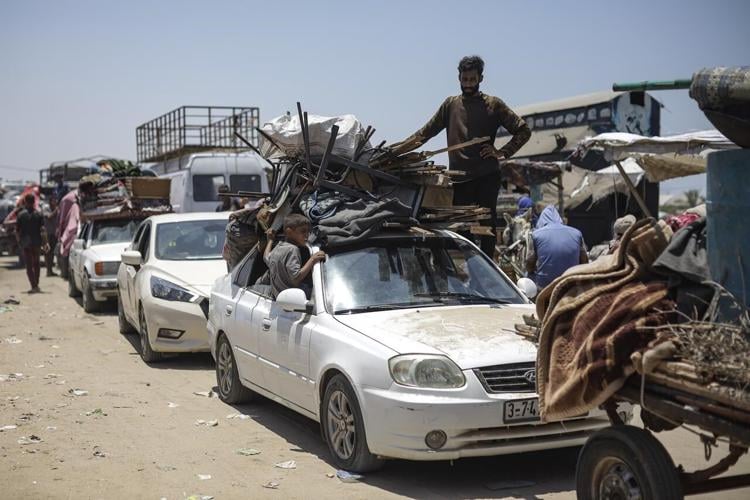Thousands flee as Israel seizes Rafah in new Gaza 'security zone'

Hundreds of thousands of Gazans were displaced on Thursday, in one of the largest evacuations of the conflict, as Israeli troops moved into the devastated city of Rafah, which is part of a newly established "security zone" they aim to control.
The day after announcing their plan to seize significant areas of the densely populated region, Israeli forces entered the city on Gaza's southern border, which had previously provided shelter for those escaping other parts of the enclave.
According to Gaza's health ministry, at least 97 people were killed in Israeli airstrikes over the past 24 hours, including 20 who died in an attack on Shejaia, a neighborhood on the northern edge of Gaza City, early Thursday morning.
Later on Thursday, an Israeli airstrike targeted a school building in Gaza City, killing at least 27 Palestinians, including women and children, who had sought refuge there.
Local health authorities reported the casualties.
The Israeli military, however, stated that the strike targeted key Palestinian "terrorists."
Medics reported that three missiles hit the Dar Al-Arqam school building in Gaza City's Tuffah neighborhood.
The Israeli military, however, claimed the strike targeted a command center used by militants to plan and carry out attacks against Israeli civilians and soldiers.
A father of seven, among the many fleeing Rafah to nearby Khan Younis, described the devastation, telling Reuters via a chat app, "Rafah is gone, it is being wiped out."
"They are knocking down what is left standing of houses and property," said the man, who declined to be identified for fear of repercussions.
The assault to capture Rafah is a major escalation in the war, which Israel restarted last month after effectively abandoning a ceasefire in place since January.
In Shejaia, a northern district where Israel had instructed the population to evacuate, hundreds of residents fled on Thursday.
Some carried their belongings, while others used donkey carts, bikes, or vans to escape.
"I want to die. Let them kill us and free us from this life. We’re not living, we’re dead," said Umm Aaed Bardaa, expressing the despair of the situation.
In Khan Younis, where several people were killed in an airstrike, Adel Abu Fakher was assessing the damage to his tent.
"There’s nothing left for us. We’re being killed while asleep," he said, reflecting the tragedy and helplessness experienced by many.
Israel has not clarified its long-term objectives for the security zone its forces are currently securing.
Prime Minister Benjamin Netanyahu stated that troops are advancing into an area he referred to as the "Morag Axis," named after a former Israeli settlement that once stood between Rafah and Khan Younis.
Gazans who had returned to their homes during a brief ceasefire have now been instructed to evacuate once more from communities on both the northern and southern edges of the Gaza Strip.
Many fear that Israel's ultimate goal is to permanently depopulate these areas, potentially leaving hundreds of thousands of people homeless, while also seizing Gaza's remaining agricultural land and essential water resources.
Since the expiration of the first phase of the ceasefire at the start of March, without an agreement to extend it, Israel has imposed a complete blockade on all goods destined for Gaza’s 2.3 million residents, creating what international organizations describe as a humanitarian catastrophe.
On Thursday, Israel's military announced that it was investigating the deaths of 15 Palestinian aid workers found in a shallow grave in March near Red Crescent vehicles, an incident that sparked global concern.
The military claimed its troops fired on the vehicles under the belief they were transporting fighters.
Israel’s primary goal since the war’s onset has been to dismantle Hamas, the militant group that ruled Gaza for nearly two decades.
However, with no alternative governance set up, Hamas regained control during the ceasefire.
Fighters from Hamas still hold 59 hostages, both dead and alive, whom Israel insists must be released to extend the truce temporarily.
Hamas, on the other hand, states it will free them only if a permanent end to the war is part of the agreement.
Israeli leaders have pointed to protests in Gaza against Hamas, with hundreds demonstrating in Beit Lahiya on Wednesday, as signs of opposition to the group’s rule.
